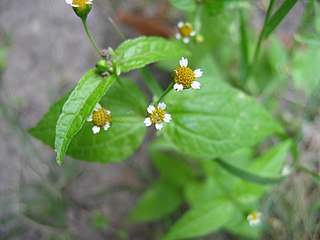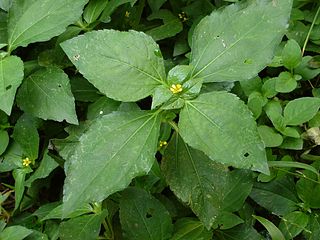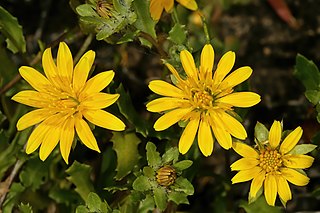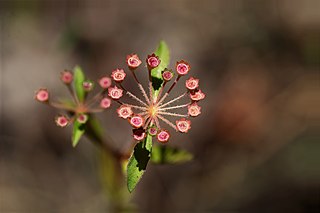
Antennaria is a genus of dioecious perennial herbs in the family Asteraceae, native to temperate regions of the Northern Hemisphere, with a few species in temperate southern South America; the highest species diversity is in North America. Common names include catsfoot or cat's-foot, pussytoes and everlasting.

Joseph Gaertner was a German botanist, best known for his work on seeds, De Fructibus et Seminibus Plantarum (1788-1792).

Xylomelum is a genus of six species of flowering plants, often commonly known as woody pears, in the family Proteaceae and are endemic to Australia. Plants in this genus are tall shrubs or small trees with leaves arranged in opposite pairs, relatively small flowers arranged in spike-like groups, and the fruit a woody, more or less pear-shaped follicle.

Gazania is a genus of flowering plants in the family Asteraceae, native to Southern Africa.

Talinum paniculatum is a succulent subshrub in the family Talinaceae that is native to much of North and South America, and the Caribbean countries. It is commonly known as fameflower, Jewels-of-Opar, or pink baby's-breath.

Galinsoga parviflora is a herbaceous plant in the Asteraceae (daisy) family. It has several common names including guasca (Colombia), pacpa yuyo, paco yuyo, and waskha (Peru), burrionera (Ecuador), albahaca silvestre and saetilla (Argentina), mielcilla, piojito, galinsoga, gallant soldier, quickweed, and potato weed.

Pulicaria is a genus of flowering plant in the sunflower family, native to Europe, Asia, and Africa. In North America Pulicaria is known by the common name false fleabane.

Psydrax is a genus of flowering plants in the family Rubiaceae. It consists of trees, shrubs, and a few lianas in the paleotropics.

Eleusine is a genus of Asian, African, and South American plants in the grass family, sometimes called by the common name goosegrass. One species (Eleusine indica), is a widespread weed in many places. Another species Eleusine coracana, is finger millet, cultivated as a cereal grain in India and parts of Africa.

Aegiceras is a genus of trees and shrubs from Southeast Asia, Malesia, Australia and the Pacific Island,. and in Australia, in the Northern Territory, Queensland, New South Wales, and Western Australia. They occur as mangroves in coastal or estuarine areas.

Melaleuca viridiflora, commonly known as broad-leaved paperbark, is a plant in the myrtle family Myrtaceae, and is native to woodlands, swamps and streams in monsoonal areas of northern Australia and New Guinea. It is usually a small tree with an open canopy, papery bark and spikes of cream, yellow, green or red flowers.
Disparago is a genus of flowering plants in the family Asteraceae.
Ophiuros is a genus of Asia, Australian, and East African plants in the grass family.

Ursinia is a genus of African plants in the chamomile tribe within the daisy family. The genus is named in honor of German scholar Johannes Heinrich Ursinus 1608–1667.

Synedrella is a genus of flowering plants in the family Asteraceae.

Cuspidia is a genus of flowering plants in the daisy family.
Crepis zacintha, the striped hawksbeard, is a plant species native to southern Europe but now naturalized on roadsides and other disturbed sites in Texas, Israel, Cyprus, and the United Kingdom.

Baeckea imbricata, commonly known as heath myrtle, is a species of flowering plant in the family Myrtaceae and is endemic to eastern Australia. It is a shrub with elliptical to egg-shaped or round leaves and small white flowers with five to twelve stamens.

Pomax is a genus of flowering plants in the coffee family, Rubiaceae. Pomax umbellata, found in Australia, is the sole species of the genus. The genus was created in 1830, by the Swiss taxonomist Augustin Pyramus de Candolle, and published in his Prodromus Systematis Naturalis Regni Vegetabilis. Pomax umbellata was first described as Opercularia umbellata by Joseph Gaertner in 1788. but was transferred to the genus, Pomax by Daniel Solander in 1834.

















